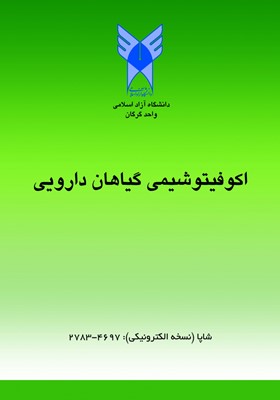بررسی فیتوشیمیایی، ضدباکتریایی و ضدقارچی اسانس دو گونه از گیاه دارویی (Thymus daenensis و Thymus fedtschenkoi) در غرب ایران
محورهای موضوعی : گیاهان دارویی
حسن مومیوند
1
*
![]() ,
پریسا خانی زاده
2
,
حمید حسنیان خوشرو
3
,
پریسا خانی زاده
2
,
حمید حسنیان خوشرو
3
1 - گروه علوم باغبانی، دانشکده کشاورزی، دانشگاه لرستان، خرم آباد، ایران
2 - گروه علوم باغبانی، دانشکده کشاورزی، دانشگاه لرستان، خرم آباد، ایران
3 - استادیار، سازمان تحقیقات، آموزش و ترویج کشاورزی، موسسه تحقیقات کشاورزی دیم کشور، مراغه، ایران
کلید واژه:
چکیده مقاله :
در این تحقیق به منظور بررسی فیتوشیمیایی، ضدباکتریایی و ضدقارچی دو گونه از آویشن دنایی (Thymus daenensis Celak.) و آویشن قرهباغی (Thymus fedtschenkoi Ronniger .) علیه باکتریهای گرم مثبت (Bacillus cereus و Staphylococcus aureus وEnterococcus faecium)، باکتریهای گرم منفی (Escherichia coli و Salmonella enteritidis) و قارچ (Candida albicans) ، سرشاخه های گلدار گیاهان بهترتیب از اراک و همدان، در مرحله گلدهی کامل برداشت شد. اسانس گیری به روش تقطیر با آب (طرح کلونجر) و شناسایی ترکیبات اسانسها توسط کروماتوگرافی گازی متصل به طیف سنج جرمی (GC/MS)انجام گردید. بررسی ضد میکروبی با استفاده از روش های دیسک دیفیوژن ، میکرودایلوشن ، حداقل غلظت مهارکنندگی (MIC) و حداقل غلظت کشندگی باکتری (MBC) محاسبه گردید. نتایج نشان داد محتوی اسانس آویشن دنایی (3/4 درصد) بیشتر از آویشن قرهباغی (2/9 درصد) بود. لینالول (83/1 درصد) و تیمول (73/9 درصد) به ترتیب مهمترین ترکیبات آویشن قرهباغی و آویشن دنایی را تشکیل دادند و اینکه اسانس هر دو گونه دارای اثر ضدباکتریایی و ضدقارچی قابل توجهی بودند؛ بهطور کلی فعالیت ضدباکتریایی اسانس آویشن قرهباغی بهویژه در مورد باکتریهای گرم مثبت بیشتر از اسانس آویشن دنایی بود. درحالی که فعالیت ضدباکتریای اسانس آویشن دنایی بر اشرشیاکلی (گرم منفی) بیشتر از اسانس آویشن قرهباغی بود. فعالیت ضدقارچی اسانس آویشن دنایی در مقایسه با آویشن قرهباغی بر قارچ کاندیدیا آلبیکنس نیز بیشتر بود. ترکیبات لینالول و تیمول از مهمترین ترکیبات با اثر ضدمیکروبی در هر دو گونه گزارش شده است.
In this study, the essential oils of Thymus daenensis and Thymus fedtschenkoi were investigated in terms of phytochemical, antibacterial, and antifungal properties. After identifying the essential compounds of these two species of thyme, their antimicrobial properties against Gram-positive bacteria (Bacillus cereus, Staphylococcus aureus, and Enterococcus faecium), Gram-negative bacteria (Escherichia coli, Salmonella enteritidis), and fungus (Candida albicans) were investigated. For this purpose, the flowering branches of T. daenensis and T. fedtschenkoi were collected at full flowering stage from west of Iran (Arak and Hamedan, respectively) in June. Then, the constituents of the essential oils were identified by gas chromatography-mass spectrometry (GC/MS). To determine the sensitivity of microbial agents to the essential oil of these plants, disk diffusion and microdilution methods were used. The minimum inhibitory concentration (MIC) and the minimum bactericidal concentration (MBC) of the essential oils of both plants were determined against bacteria and fungi. Based on the results, the essential oil content of T. daenensis (3.4%) was more than that of T. fedtschenkoi (2.9%). The main compositions of the essential oils of T. fedtschenkoi and T. daenensis were linalool (83.1%) and thymol (73.9%), respectively. The essential oils of both species had significant antibacterial and antifungal effects albeit with different levels. In general, the antibacterial activity of T. fedtschenkoi essential oil was higher than that of T. daenensis, especially in the case of gram-positive bacteria. On the other hand, the antibacterial activity of T. daenensis essential oil against E. coli (gram negative) was more than that of T. fedtschenkoi. Antifungal activity of T. daenensis essential oil was higher than that of T. fedtschenkoi against C. albicans. The essential oil of T. fedtschenkoi was rich in linalool, and the higher antimicrobial activity of this species could be attributed to the high percentage of this compound in comparison with T. daenensis.

